Paper Menu >>
Journal Menu >>
 Applied Mathematics, 2011, 2, 487-495 doi:10.4236/am.2011.24063 Published Online April 2011 (http://www.SciRP.org/journal/am) Copyright © 2011 SciRes. AM Embedding-Based Sliding Mode Control for Linear Time Varying Systems Mohammad Reza Zarrabi1, Mohammad Hadi Farahi1, Ali Jafar Koshkouei2, Sohrab Effati1, Keith Burnham2 1Department of Applied Mathematics, Ferdowsi University of Mashhad, Mashhad, Iran 2Control Theory and Applications Centre, Coventry University, Coventry, UK E-mail: s-effati@um.ac.ir Received February 20, 2011; revised March 10, 2011; accepted March 13, 2011 Abstract In this paper, a novel strategy using embedding process and sliding surface is proposed. In this method, a state trajectory starting from a given initial point reaches a definite point on a sliding surface in the minimum time, and then tends to the origin along the sliding surface (SS). In the first, a SS is designed, then using an appropriate measure, an embedding is constructed to solve a time optimal control problem such that the sys- tem trajectory reaches the SS in minimum time, after that a control is designed such that the system trajecto- ry tends to the origin along the SS. It is well-known that the main disadvantage of the use of sliding mode controls (SMCs) is a phenomenon, the so-called chattering. The proposed SMC here is piecewise continuous and chattering free. Some numerical examples is presented to illustrate the effectiveness and reliability of the proposed method. Keywords: Time Optimal Control Problem, Measure Theory, Sliding Mode Control, Sliding Surface Design, Equivalent Control 1. Introduction The concept of sliding mode control (SMC) introduced a second order system by Emel’yanov [1] in the late 1960s based on the conceptions of variable structure control (VSC) in which the second order system trajectories has been driven towards a line in the state space termed as the sliding line and enforcing the trajectories to the origin. However, Flügge-Lotz [2] was the first to present the concept of sliding motion, and Filippov [3] was the first to consider the solution of differential equations with a discontinuous right-hand side. Filippov’s pioneering work still serves as the basis for work in sliding mode control which was essentially developed by Utkin [4] and Emel’yanov [1,5], Draženović [6] and their co-workers. The pioneering work had not been presented the out- side of Russia until the mid 1970s when a book by Itkis [7] and a survey paper by Utkin [8] were published in the west. SMC which is a particular type of control, known as variable structure control (VSC), is a powerful and robust control, and it has been extensively studied in the last three decades for many classes of linear and nonli- near systems, from theoretical concepts to industrial ap- plications, including autonomous underwater robot [9], continuously stirred tank reactor [10], PUMA 560 robot [11], finger for a prosthetic hand [12], cable suspended loads [13] and four rotors helicopter [14]. Utkin [4] has developed the concept of sliding mode control to guarantees the existence of a sliding mode motion. In the classical SMC approach, infinite frequen- cy control switching between different sub-controllers is required to maintain the trajectories on a prespecified surface in the state space and to eventually enforce the state trajectories to the equilibrium point along the sur- face. Therefore, the system stability and behaviour de- pend on the selection of sliding surface [8,15]. Several methods have been proposed to design a stable SS, such neural network [9], fuzzy SMC [16], SMC a system with mismatched uncertainties [17], discrete-time SMC [18], minimizing integral absolute error [19], passivity-based SMC [10,20] and flatness, back stepping with SMC [21]. SMC approach is well known as one of powerful and effective robust control approaches to reject the matched disturbances, to reduce the influence of unmatched un- certainties and insensitivity to parameter variations. How-  M. R. ZARRABI ET AL. Copyright © 2011 SciRes. AM 488 ever, the repetitious control switching creates a phenome- non, the so-called chattering, which may be dangerous and exhibits high-frequency vibrations of the controlled plant [22,23]. To overcome this unwanted behaviour, many methods including several continuous approxima- tions of the discontinuous SMCs have been proposed, in which the switching function enforces the trajectories to stay within a boundary layer of the sliding surface. The main disadvantage of such approximation is that the ro- bustness of SMC may be lost inside the boundary layer if the size of the boundary layer is not sufficiently small. In fact, the uncertainties and disturbances may influence the system behaviour. Other methods for eliminating the chattering are based on high order sliding mode control concepts in which the higher order time derivative of the switching function is used. The traditional discontinuous sliding mode control enforces the state trajectories on the sliding surface while the continuous part of sliding mode control imposes the trajectories remain on the surface after a finite time. The continuous part has a particular structure which leads to the invariance conditions for the sliding motion and in the average sense; it is termed the equivalent control. On the other hand, many methods based on sliding mode and output feedback control schemes have been also proposed for robust stabilisation of uncertain sys- tems [24,25]. El-Khazali and DeCarlo [25] have de- signed sliding surfaces for linear time-invariant systems without disturbances using eigenvalue assignment and eigenvector techniques. Żak and Hui [24] have devel- oped a geometric condition to guarantee the existence of a SS and the stability of the reduced order sliding motion. Most established results are based on the matched dis- turbances, i.e. the disturbances acts in the channels of the inputs. Even when there are uncertainties in the system with unknown structure, SMC is an appropriate control design method. When the system is in a sliding mode, the dimension of the system is reduced and it is the same the SS. This subsystem is termed the reduced-order sys- tem, and the stability of the original system depends on the stability of this subsystem. In this paper, a novel strategy based on measure theory and sliding surface is proposed to design an almost time optimal control as well as a sliding mode control to en- force the system trajectories from an initial point to a definite point on the designed SS in minimum time, and then force the trajectories tend to the equilibrium points along the SS. In fact, the entire of control design is com- pleted in three steps. In the first step, the SS is designed. In the second step, the minimum time optimal control problem from an initial point to a given point on the SS, is solved. In the third step, an equivalent control is de- signed such that the system trajectories tend to the equi- librium point along the SS. In fact, the trajectory moves along the SS and eventually reaches the equilibrium point (say origin) in infinite-horizon. The proposed con- troller is piecewise continuous and yields a chattering free motion. Furthermore, this method guarantees a slid- ing mode motion and system stability. Moreover, the proposed approach is straightforward without requiring any predication or conditions on the initials and using any iterative algorithm. This paper is organised as follows: Section 2 briefly introduces SMC. Section 3 addresses the functional space and measure theory facts which are used in this paper. Section 4 addresses the proposed SMC approach. In Sec- tion 5, some examples are presented to illustrate the pro- cedure and validity of the proposed control design. Fi- nally, conclusions are given in Section 6. 2. SMC Design Consider the linear time varying system x ttxttut AB, (2.1) 0 0 x x , and the equilibrium point is the origin, where nn A , nm B, while xt is the state and ut is the control input. The sets and are bounded, closed subsets respectively in n and m . It is assumed that 1mn and the input distribution matrix B has full rank. Define the sliding function as: s xGx, (2.2) where mn G and the sliding surface as: :0 n Sx sx . (2.3) It is also assumed that GB t is a nonsingular matrix. Suppose there exists a finite time s t such that the so- lution of (2.1) represented by x t satisfies 0 for all s s xtt t , then an ideal sliding motion is said to be taking place for all s tt. Time s t is termed the reaching time and it is the time that the system trajectories (2.1) lie on the sur- face (2.3). This fact can be mathematically expressed as 0st Gxt and 0st Gxt for all s tt. In this paper an almost optimal control ao u is de- signed to ensure the trajectories hits the SS in minimum time. Then using the sliding mode conditions 0st and 0st as two extra boundary conditions, a sub- control eq u is designed such that the trajectories con- verge to the equilibrium point. Thus the traditional SMC is defined as: if 0 if ao s eq s utt uutt (2.4)  M. R. ZARRABI ET AL. Copyright © 2011 SciRes. AM 489 where s t is the reaching time to theSS, i.e. 0 s St . In fact, ao u is a sub-controller which impose the trajec- tory that moves from an initial point hits the sliding sur- face at point C in minimum time and eq u is the equi- valent control which forces the trajectory moves from C to the equilibrium point along SS. The sliding surface is selected such that the reduced- order system, i.e. the system during the sliding mode, is stable and crosses from the point C. To find the beha- viour of the sliding mode system, the system may be decomposed into two subsystems as it is presented here. If the states are partitioned so that 1 2 x x x (2.5) where 1 nm x and 2 m x, then the linear system (2.1) can be written as the following regular form 1111122 x txttx t AA (2.6) 221122 22 x txttx ttut AAB, (2.7) where the sub-matrices 11 tA, 12 tA, 21 tA, 22 tA, and 2tB are defined appropriately. (See [26] for more details) Equation (2.6), which is independent of the control, considers as a system that shows sliding motion (the re- duced-order system or the system in the sliding mode). In the next section, we briefly introduce the functional space used in embedding method. 3. Functional Space To describe our embedding method, consider the general following control system: ,, x tgtxu (3.1) .. , ab s txaxxb x, (3.2) where a and b are two nonnegative numbers with ab , .tab, the trajectory function . x satisfies xt and is absolutely continuous, the control func- tion .u is Lebesgue measurable and ut , where and are respectively closed, and bounded sub- sets in n and m , and :, n gab is a continuous time varying vector function. Clearly the operating regions and are com- pact sets and , ab xx. It is desired to design the con- trol u such that the system trajectory starting from the initial state a x reaches the final state b x at tb . An optimal control problem is presented as the following: Minimise: 0 ,,,d b a J xuf txut (3.3) subject to: ,, x tgtxu (3.4) , ab x axxbx , (3.5) where 0:,fab is a continuous function. The pair ,wxu satisfying the conditions (3.4) and (3.5) is termed admissible. The set of all ad- missible pairs, is denoted by W. Now, one seeks to find an optimal pair ** * ,wxu W which gives the minimum value of , J xu defined in (3.3). In general the minimisation of the functional (3.3) over W may not always possible. The set W may be empty, even if W is not a null set, the functional measuring the per- formance of the system may not achieves its minimum in this set. It appears that the situation may become more promising if the set W could somehow be made larger. In the following a transformation is used to enlarge the set W. Let ,wxu be an admissible pair and B an open ball containing I where , I ab. Let CB where CB denotes the space of real- valued continuously differentiable functions on B. De- fine the function g as d ,, , d ,,, ,, g xt txt uttxt t txtgtxt uttxt (3.6) with ,,txt utI for all tI . The function g is in the space C, the set of all con- tinuous functions on the compact set . For each ad- missible pair, ,, d,, . bg atxt uttbxbaxa CB (3.7) Let 0 DI be the space of infinitely differentiable real-valued functions with a compact support in 0 I , where 0, I ab. Define 0 d ,, d ,, , , 1,2,,. jj jj txt uttx t t tx ttgtxt ut DI jn (3.8) Then, if ,wxu is an admissible pair, for every 0 DI , ,,d0, 1,2,,. b j atxt uttjn (3.9) Let 1 C be a subspace of the space C of all bounded continuous functions on depending only on the variable t. Now, by selecting the function 1 fC , it is obtained 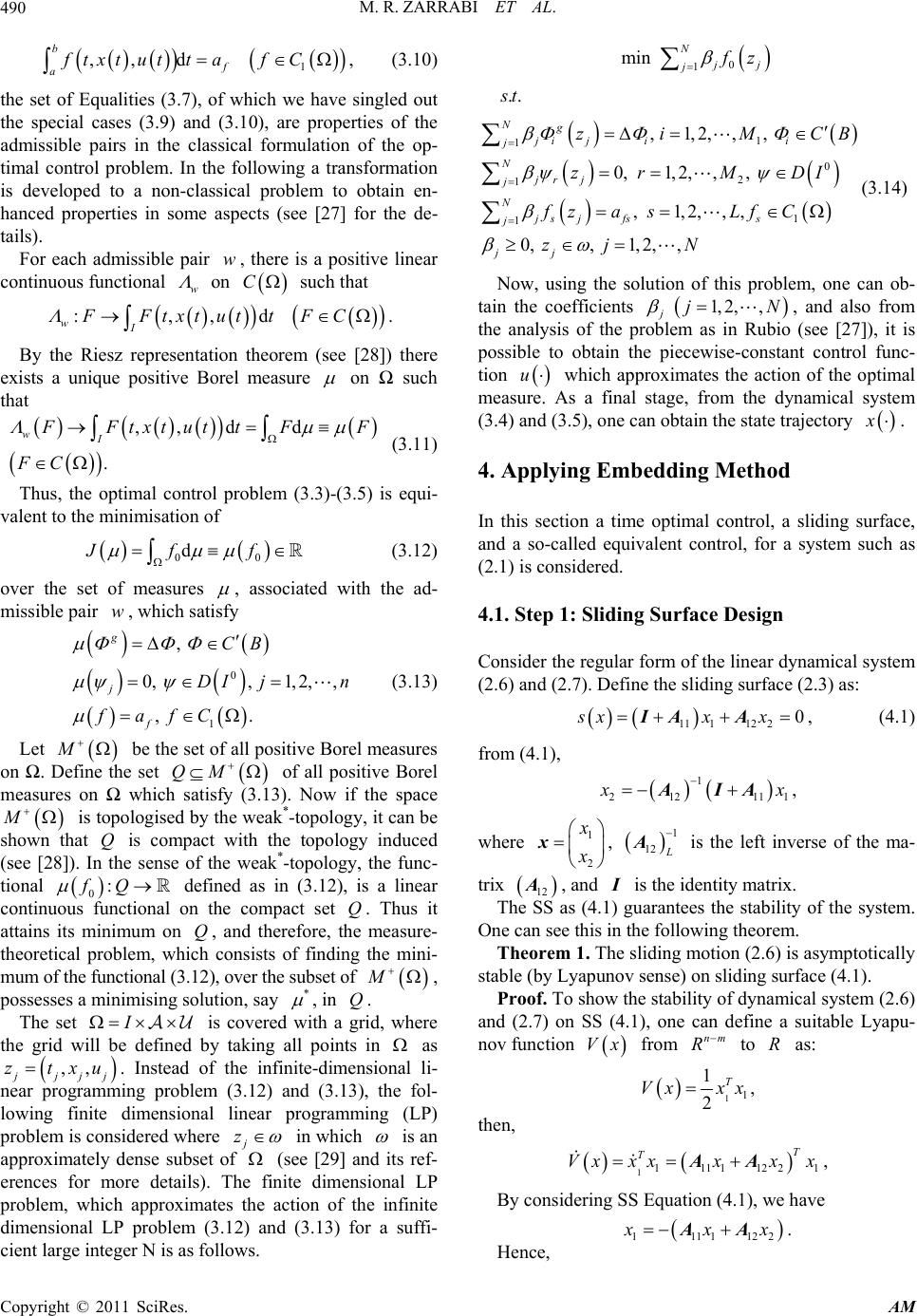 M. R. ZARRABI ET AL. Copyright © 2011 SciRes. AM 490 1 ,,d b f aftxt uttafC , (3.10) the set of Equalities (3.7), of which we have singled out the special cases (3.9) and (3.10), are properties of the admissible pairs in the classical formulation of the op- timal control problem. In the following a transformation is developed to a non-classical problem to obtain en- hanced properties in some aspects (see [27] for the de- tails). For each admissible pair w, there is a positive linear continuous functional w on C such that :,,d wI FFtxtuttFC . By the Riesz representation theorem (see [28]) there exists a unique positive Borel measure on Ω such that ,, dd . wI F Ftxt uttFF FC (3.11) Thus, the optimal control problem (3.3)-(3.5) is equi- valent to the minimisation of 00 dJff (3.12) over the set of measures , associated with the ad- missible pair w, which satisfy 0 1 , 0, , 1,2,, , . g j f CB DI jn fafC (3.13) Let M be the set of all positive Borel measures on Ω. Define the set QM of all positive Borel measures on Ω which satisfy (3.13). Now if the space M is topologised by the weak*-topology, it can be shown that Q is compact with the topology induced (see [28]). In the sense of the weak*-topology, the func- tional 0:fQ defined as in (3.12), is a linear continuous functional on the compact set Q. Thus it attains its minimum on Q, and therefore, the measure- theoretical problem, which consists of finding the mini- mum of the functional (3.12), over the subset of M , possesses a minimising solution, say * , in Q. The set I is covered with a grid, where the grid will be defined by taking all points in as ,, j jjj ztxu. Instead of the infinite-dimensional li- near programming problem (3.12) and (3.13), the fol- lowing finite dimensional linear programming (LP) problem is considered where j z in which is an approximately dense subset of (see [29] and its ref- erences for more details). The finite dimensional LP problem, which approximates the action of the infinite dimensional LP problem (3.12) and (3.13) for a suffi- cient large integer N is as follows. 0 1 min N j j j f z .. s t 1 1 0 2 1 1 1 , 1,2,,, 0, 1,2,,, , 1,2,,, 0, , 1,2,, Ng ji jii j N jr j j N js jfss j jj ziMCB zr MDI fzasLf C zj N (3.14) Now, using the solution of this problem, one can ob- tain the coefficients 1, 2,, jjN , and also from the analysis of the problem as in Rubio (see [27]), it is possible to obtain the piecewise-constant control func- tion u which approximates the action of the optimal measure. As a final stage, from the dynamical system (3.4) and (3.5), one can obtain the state trajectory x . 4. Applying Embedding Method In this section a time optimal control, a sliding surface, and a so-called equivalent control, for a system such as (2.1) is considered. 4.1. Step 1: Sliding Surface Design Consider the regular form of the linear dynamical system (2.6) and (2.7). Define the sliding surface (2.3) as: 11112 20sxx x IA A, (4.1) from (4.1), 1 212 111 x x AIA , where 1 2 x x x, 1 12 L A is the left inverse of the ma- trix 12 A , and I is the identity matrix. The SS as (4.1) guarantees the stability of the system. One can see this in the following theorem. Theorem 1. The sliding motion (2.6) is asymptotically stable (by Lyapunov sense) on sliding surface (4.1). Proof. To show the stability of dynamical system (2.6) and (2.7) on SS (4.1), one can define a suitable Lyapu- nov function Vx from nm R to R as: 11 1 2 T Vx xx, then, 111111221 T T Vx xxxx x AA, By considering SS Equation (4.1), we have 1111122 x xx AA. Hence, 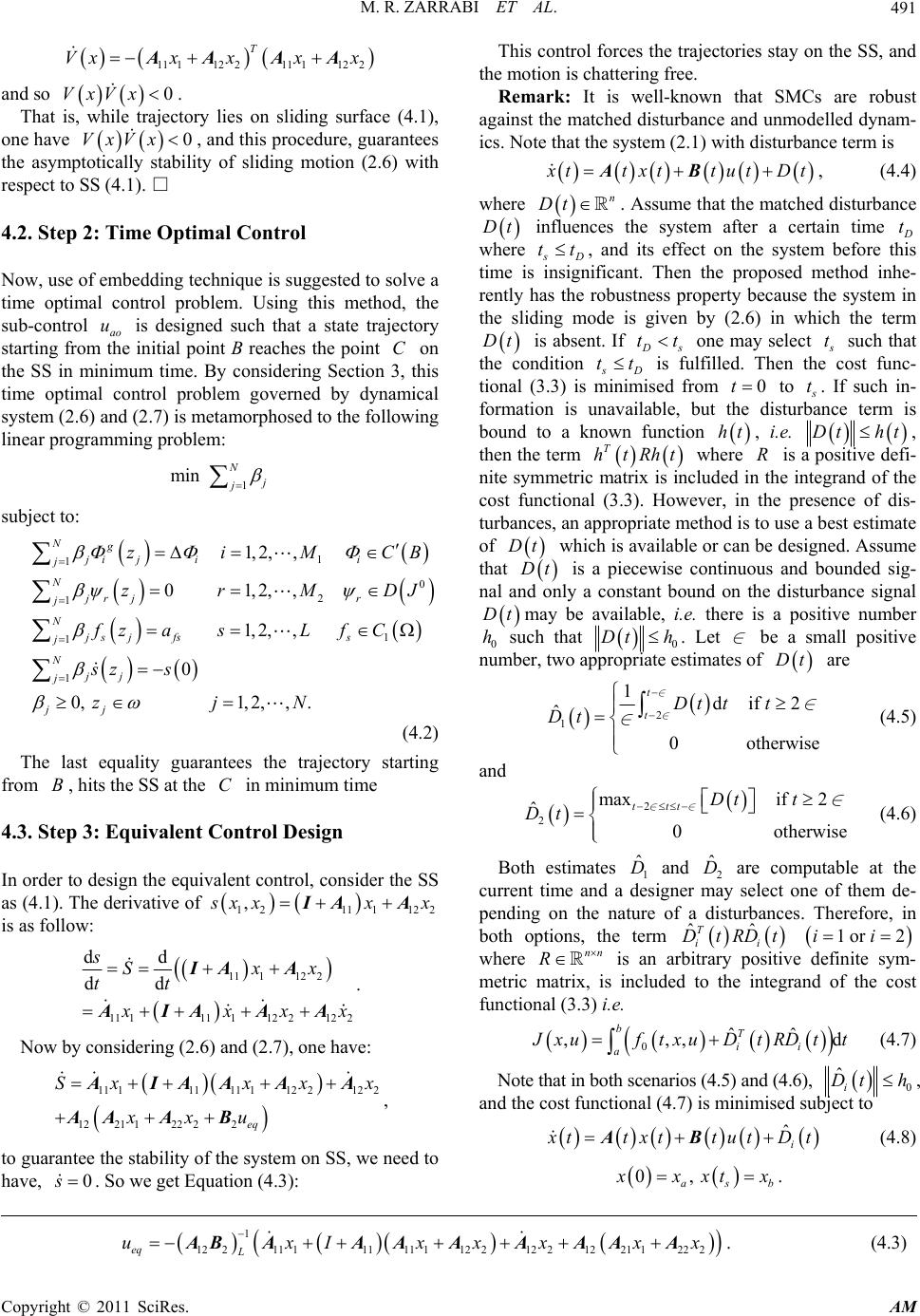 M. R. ZARRABI ET AL. Copyright © 2011 SciRes. AM 491 11 112211 1122 T Vxx xx x AA AA and so 0VxVx . That is, while trajectory lies on sliding surface (4.1), one have 0VxVx , and this procedure, guarantees the asymptotically stability of sliding motion (2.6) with respect to SS (4.1). □ 4.2. Step 2: Time Optimal Control Now, use of embedding technique is suggested to solve a time optimal control problem. Using this method, the sub-control ao u is designed such that a state trajectory starting from the initial point B reaches the point C on the SS in minimum time. By considering Section 3, this time optimal control problem governed by dynamical system (2.6) and (2.7) is metamorphosed to the following linear programming problem: 1 min N j j subject to: 1 1 0 2 1 1 1 1 1,2,, 0 1,2,, 1,2,, 0 0, 1,2,,. Ng ji jii j N jr jr j N js jfss j N jj j jj ziMCB zrMDJ fzasLf C sz s zjN (4.2) The last equality guarantees the trajectory starting from B, hits the SS at the C in minimum time 4.3. Step 3: Equivalent Control Design In order to design the equivalent control, consider the SS as (4.1). The derivative of 1211 1122 , s xxx x IAA is as follow: 11112 2 11 1111122122 dd dd sSxx tt x xxx IA A AIAAA . Now by considering (2.6) and (2.7), one have: 11 11111 1122122 1221 12222eq Sxxxx xxu AIAAAA AA AB, to guarantee the stability of the system on SS, we need to have, 0s . So we get Equation (4.3): This control forces the trajectories stay on the SS, and the motion is chattering free. Remark: It is well-known that SMCs are robust against the matched disturbance and unmodelled dynam- ics. Note that the system (2.1) with disturbance term is x ttxttutDt AB , (4.4) where n Dt. Assume that the matched disturbance Dt influences the system after a certain time D t where s D tt , and its effect on the system before this time is insignificant. Then the proposed method inhe- rently has the robustness property because the system in the sliding mode is given by (2.6) in which the term Dt is absent. If D s tt one may select s t such that the condition s D tt is fulfilled. Then the cost func- tional (3.3) is minimised from 0t to s t. If such in- formation is unavailable, but the disturbance term is bound to a known function ht , i.e. Dt ht, then the term T htRht where R is a positive defi- nite symmetric matrix is included in the integrand of the cost functional (3.3). However, in the presence of dis- turbances, an appropriate method is to use a best estimate of Dt which is available or can be designed. Assume that Dt is a piecewise continuous and bounded sig- nal and only a constant bound on the disturbance signal Dt may be available, i.e. there is a positive number 0 h such that 0 Dt h . Let be a small positive number, two appropriate estimates of Dt are 2 1 1dif 2 ˆ 0otherwise t tDt tt Dt (4.5) and 2 2 maxif 2 ˆ 0otherwise tttDt t Dt (4.6) Both estimates 1 ˆ D and 2 ˆ D are computable at the current time and a designer may select one of them de- pending on the nature of a disturbances. Therefore, in both options, the term ˆˆ T ii DtRDt 1 or 2ii where nn R is an arbitrary positive definite sym- metric matrix, is included to the integrand of the cost functional (3.3) i.e. 0ˆˆ ,,, d bT ii a J xuftxuDt RDtt (4.7) Note that in both scenarios (4.5) and (4.6), 0 ˆi Dth , and the cost functional (4.7) is minimised subject to ˆi x ttxttutDt AB (4.8) 0, asb x xxt x . 1 12211 1111111221221221 1222eq L uxIxxxxx ABAAAAAA AA. (4.3) 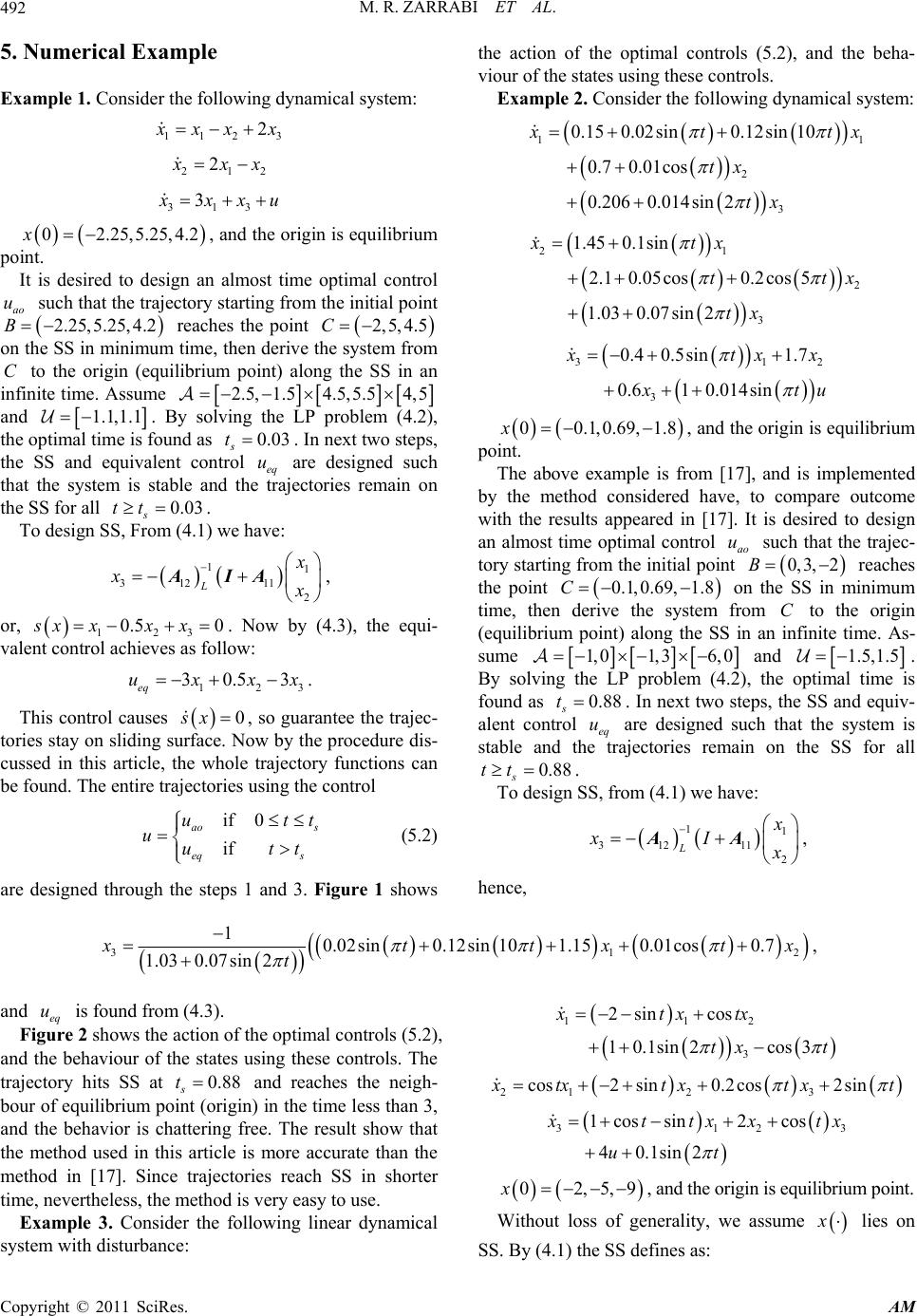 M. R. ZARRABI ET AL. Copyright © 2011 SciRes. AM 492 5. Numerical Example Example 1. Consider the following dynamical system: 112 3 2 x xx x 212 2 x xx 313 3 x xxu 02.25,5.25,4.2x , and the origin is equilibrium point. It is desired to design an almost time optimal control ao u such that the trajectory starting from the initial point 2.25,5.25, 4.2B reaches the point 2, 5, 4.5C on the SS in minimum time, then derive the system from C to the origin (equilibrium point) along the SS in an infinite time. Assume 2.5, 1.54.5,5.54,5 and 1.1,1.1 . By solving the LP problem (4.2), the optimal time is found as 0.03 s t . In next two steps, the SS and equivalent control eq u are designed such that the system is stable and the trajectories remain on the SS for all 0.03 s tt. To design SS, From (4.1) we have: 11 312 11 2 L x x x AIA , or, 123 0.5 0sxxx x . Now by (4.3), the equi- valent control achieves as follow: 123 30.53 eq uxxx . This control causes 0sx , so guarantee the trajec- tories stay on sliding surface. Now by the procedure dis- cussed in this article, the whole trajectory functions can be found. The entire trajectories using the control if 0 if ao s eq s utt uutt (5.2) are designed through the steps 1 and 3. Figure 1 shows the action of the optimal controls (5.2), and the beha- viour of the states using these controls. Example 2. Consider the following dynamical system: 11 2 3 0.150.02sin0.12sin 10 0.70.01cos 0.2060.014sin2 x ttx tx tx 21 2 3 1.45 0.1sin 2.10.05cos0.2cos5 1.030.07sin2 xtx ttx tx 312 3 0.40.5sin1.7 0.610.014sin x tx x x tu 00.1,0.69, 1.8x , and the origin is equilibrium point. The above example is from [17], and is implemented by the method considered have, to compare outcome with the results appeared in [17]. It is desired to design an almost time optimal control ao u such that the trajec- tory starting from the initial point 0, 3,2B reaches the point 0.1,0.69,1.8C on the SS in minimum time, then derive the system from C to the origin (equilibrium point) along the SS in an infinite time. As- sume 1, 01,36, 0 and 1.5,1.5 . By solving the LP problem (4.2), the optimal time is found as 0.88 s t . In next two steps, the SS and equiv- alent control eq u are designed such that the system is stable and the trajectories remain on the SS for all 0.88 s tt. To design SS, from (4.1) we have: 11 312 11 2 L x xI x AA, hence, 312 10.02sin0.12sin101.150.01cos0.7 1.030.07sin 2 x ttxtx t , and eq u is found from (4.3). Figure 2 shows the action of the optimal controls (5.2), and the behaviour of the states using these controls. The trajectory hits SS at 0.88 s t and reaches the neigh- bour of equilibrium point (origin) in the time less than 3, and the behavior is chattering free. The result show that the method used in this article is more accurate than the method in [17]. Since trajectories reach SS in shorter time, nevertheless, the method is very easy to use. Example 3. Consider the following linear dynamical system with disturbance: 112 3 2sin cos 10.1sin2cos3 xtxtx tx t 21 23 cos2 sin0.2cos2sin x txt xt xt 3123 1cos sin2cos 40.1sin2 x ttxx tx ut 02,5,9x , and the origin is equilibrium point. Without loss of generality, we assume x lies on SS. By (4.1) the SS defines as: 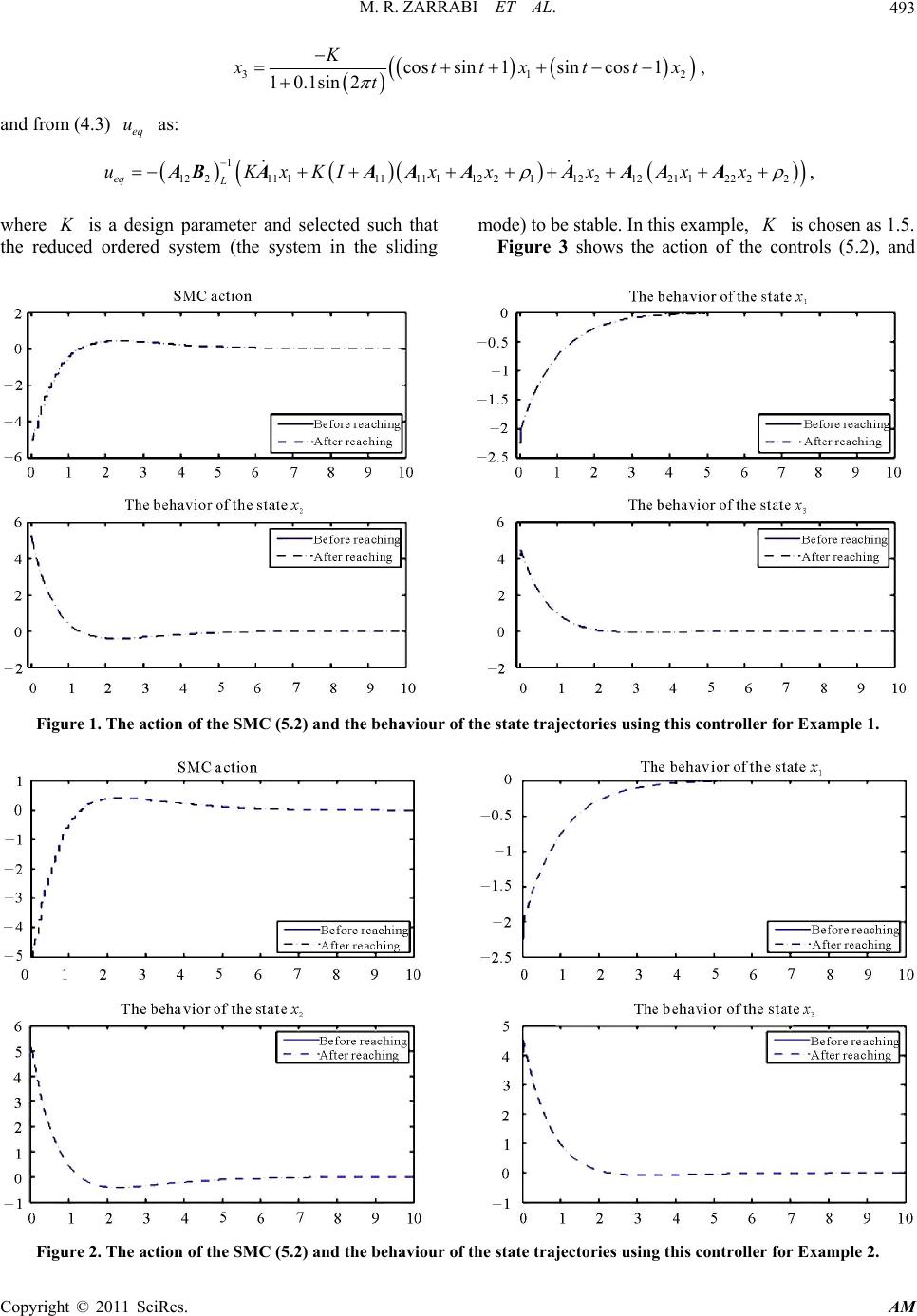 M. R. ZARRABI ET AL. Copyright © 2011 SciRes. AM 493 312 cossin1sincos1 10.1sin2 K x ttx ttx t , and from (4.3) eq u as: 1 12211 11111112211221221 12222eq L uKxKIxxxxx ABAAAAAA AA, where K is a design parameter and selected such that the reduced ordered system (the system in the sliding mode) to be stable. In this example, K is chosen as 1.5. Figure 3 shows the action of the controls (5.2), and Figure 1. The action of the SMC (5.2) and the behaviour of the state trajectories using this controller for Example 1. Figure 2. The action of the SMC (5.2) and the behaviour of the state trajectories using this controller for Example 2. 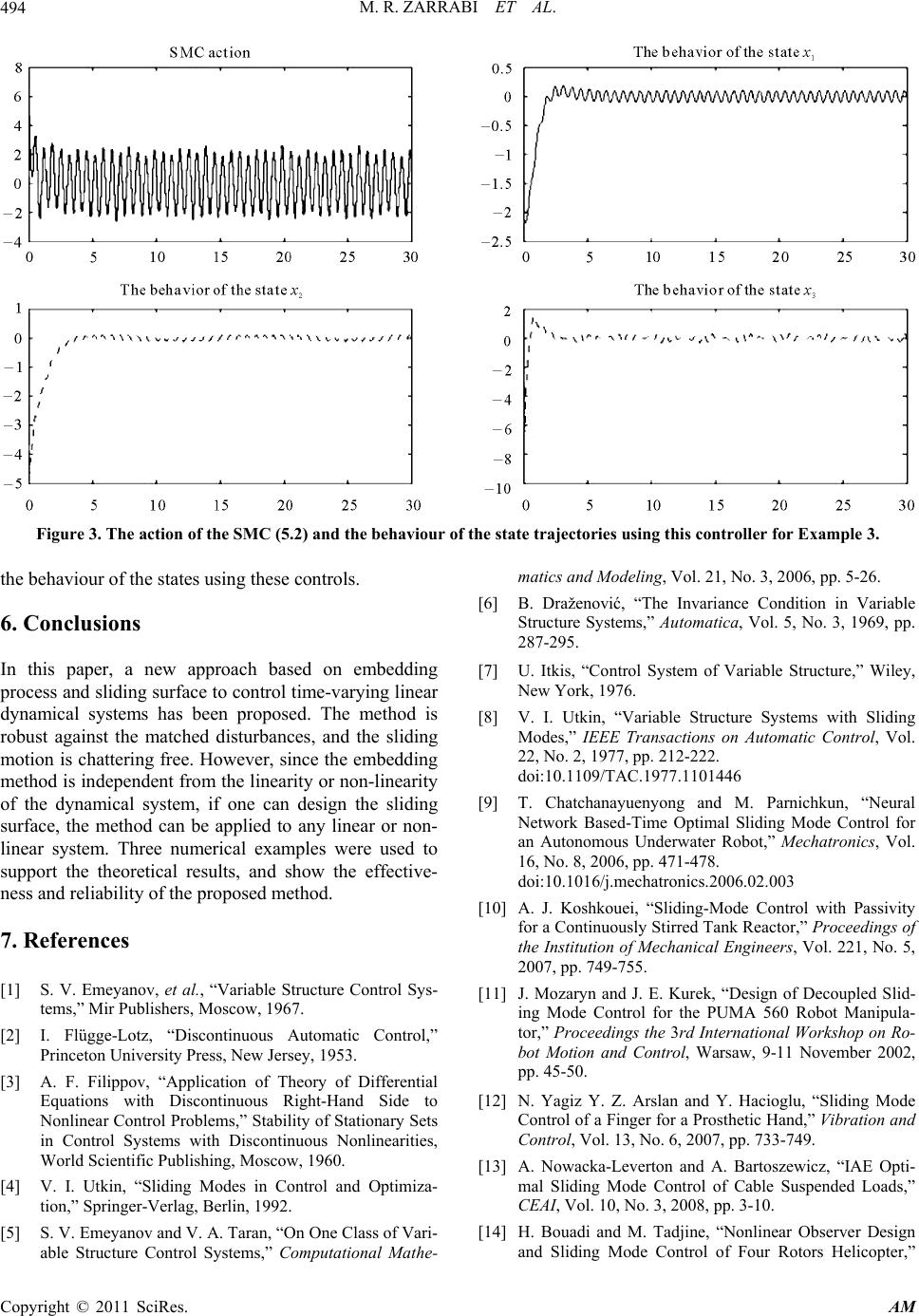 M. R. ZARRABI ET AL. Copyright © 2011 SciRes. AM 494 Figure 3. The action of the SMC (5.2) and the behaviour of the state trajectories using this controller for Example 3. the behaviour of the states using these controls. 6. Conclusions In this paper, a new approach based on embedding process and sliding surface to control time-varying linear dynamical systems has been proposed. The method is robust against the matched disturbances, and the sliding motion is chattering free. However, since the embedding method is independent from the linearity or non-linearity of the dynamical system, if one can design the sliding surface, the method can be applied to any linear or non- linear system. Three numerical examples were used to support the theoretical results, and show the effective- ness and reliability of the proposed method. 7. References [1] S. V. Emeyanov, et al., “Variable Structure Control Sys- tems,” Mir Publishers, Moscow, 1967. [2] I. Flügge-Lotz, “Discontinuous Automatic Control,” Princeton University Press, New Jersey, 1953. [3] A. F. Filippov, “Application of Theory of Differential Equations with Discontinuous Right-Hand Side to Nonlinear Control Problems,” Stability of Stationary Sets in Control Systems with Discontinuous Nonlinearities, World Scientific Publishing, Moscow, 1960. [4] V. I. Utkin, “Sliding Modes in Control and Optimiza- tion,” Springer-Verlag, Berlin, 1992. [5] S. V. Emeyanov and V. A. Taran, “On One Class of Vari- able Structure Control Systems,” Computational Mathe- matics and Modeling, Vol. 21, No. 3, 2006, pp. 5-26. [6] B. Draženović, “The Invariance Condition in Variable Structure Systems,” Automatica, Vol. 5, No. 3, 1969, pp. 287-295. [7] U. Itkis, “Control System of Variable Structure,” Wiley, New York, 1976. [8] V. I. Utkin, “Variable Structure Systems with Sliding Modes,” IEEE Transactions on Automatic Control, Vol. 22, No. 2, 1977, pp. 212-222. doi:10.1109/TAC.1977.1101446 [9] T. Chatchanayuenyong and M. Parnichkun, “Neural Network Based-Time Optimal Sliding Mode Control for an Autonomous Underwater Robot,” Mechatronics, Vol. 16, No. 8, 2006, pp. 471-478. doi:10.1016/j.mechatronics.2006.02.003 [10] A. J. Koshkouei, “Sliding-Mode Control with Passivity for a Continuously Stirred Tank Reactor,” Proceedings of the Institution of Mechanical Engineers, Vol. 221, No. 5, 2007, pp. 749-755. [11] J. Mozaryn and J. E. Kurek, “Design of Decoupled Slid- ing Mode Control for the PUMA 560 Robot Manipula- tor,” Proceedings the 3rd International Workshop on Ro- bot Motion and Control, Warsaw, 9-11 November 2002, pp. 45-50. [12] N. Yagiz Y. Z. Arslan and Y. Hacioglu, “Sliding Mode Control of a Finger for a Prosthetic Hand,” Vibration and Control, Vol. 13, No. 6, 2007, pp. 733-749. [13] A. Nowacka-Leverton and A. Bartoszewicz, “IAE Opti- mal Sliding Mode Control of Cable Suspended Loads,” CEAI, Vol. 10, No. 3, 2008, pp. 3-10. [14] H. Bouadi and M. Tadjine, “Nonlinear Observer Design and Sliding Mode Control of Four Rotors Helicopter,” 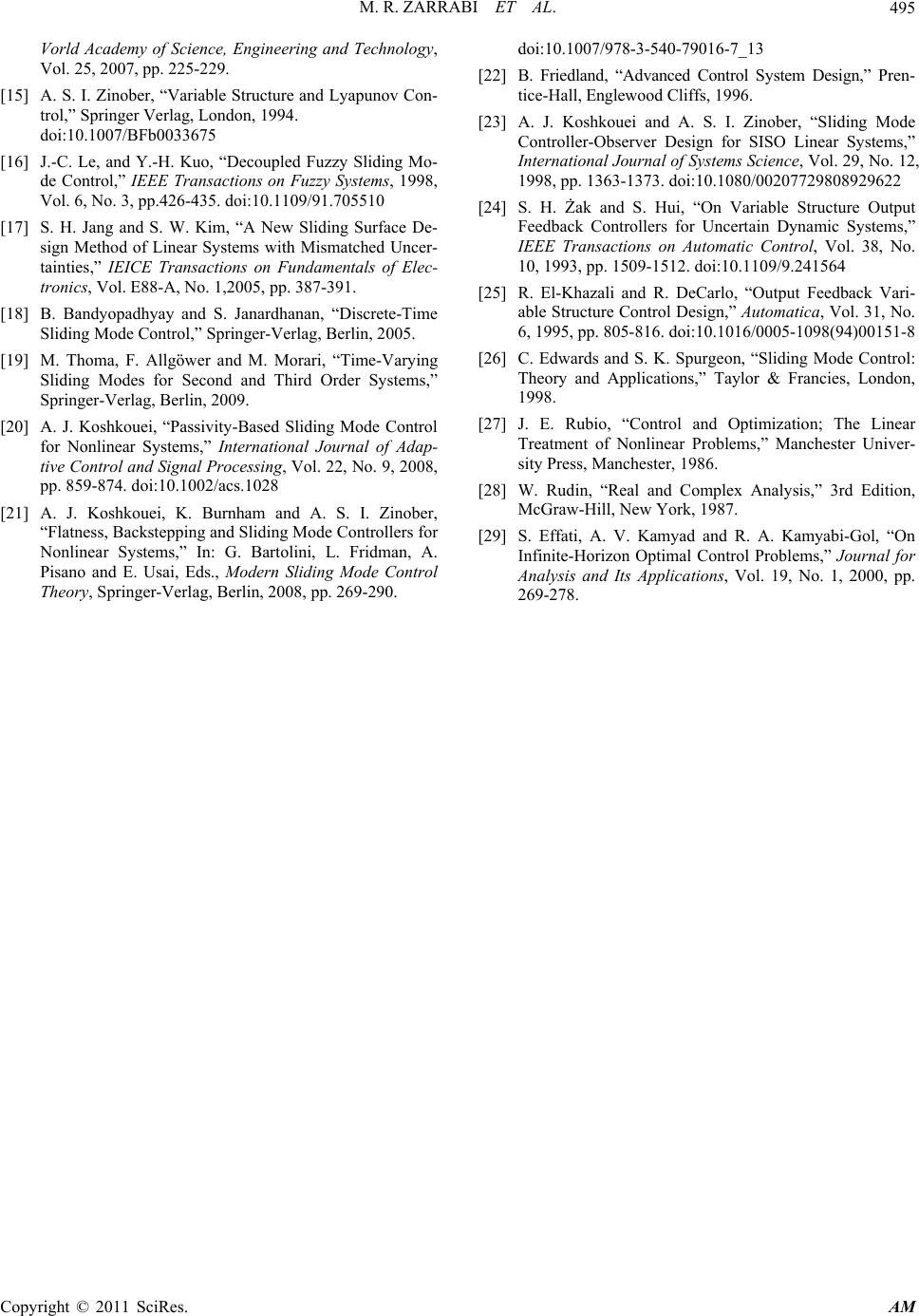 M. R. ZARRABI ET AL. Copyright © 2011 SciRes. AM 495 Vorld Academy of Science, Engineering and Technology, Vol. 25, 2007, pp. 225-229. [15] A. S. I. Zinober, “Variable Structure and Lyapunov Con- trol,” Springer Verlag, London, 1994. doi:10.1007/BFb0033675 [16] J.-C. Le, and Y.-H. Kuo, “Decoupled Fuzzy Sliding Mo- de Control,” IEEE Transactions on Fuzzy Systems, 1998, Vol. 6, No. 3, pp.426-435. doi:10.1109/91.705510 [17] S. H. Jang and S. W. Kim, “A New Sliding Surface De- sign Method of Linear Systems with Mismatched Uncer- tainties,” IEICE Transactions on Fundamentals of Elec- tronics, Vol. E88-A, No. 1,2005, pp. 387-391. [18] B. Bandyopadhyay and S. Janardhanan, “Discrete-Time Sliding Mode Control,” Springer-Verlag, Berlin, 2005. [19] M. Thoma, F. Allgöwer and M. Morari, “Time-Varying Sliding Modes for Second and Third Order Systems,” Springer-Verlag, Berlin, 2009. [20] A. J. Koshkouei, “Passivity-Based Sliding Mode Control for Nonlinear Systems,” International Journal of Adap- tive Control and Signal Processing, Vol. 22, No. 9, 2008, pp. 859-874. doi:10.1002/acs.1028 [21] A. J. Koshkouei, K. Burnham and A. S. I. Zinober, “Flatness, Backstepping and Sliding Mode Controllers for Nonlinear Systems,” In: G. Bartolini, L. Fridman, A. Pisano and E. Usai, Eds., Modern Sliding Mode Control Theory, Springer-Verlag, Berlin, 2008, pp. 269-290. doi:10.1007/978-3-540-79016-7_13 [22] B. Friedland, “Advanced Control System Design,” Pren- tice-Hall, Englewood Cliffs, 1996. [23] A. J. Koshkouei and A. S. I. Zinober, “Sliding Mode Controller-Observer Design for SISO Linear Systems,” International Journal of Systems Science, Vol. 29, No. 12, 1998, pp. 1363-1373. doi:10.1080/00207729808929622 [24] S. H. Żak and S. Hui, “On Variable Structure Output Feedback Controllers for Uncertain Dynamic Systems,” IEEE Transactions on Automatic Control, Vol. 38, No. 10, 1993, pp. 1509-1512. doi:10.1109/9.241564 [25] R. El-Khazali and R. DeCarlo, “Output Feedback Vari- able Structure Control Design,” Automatica, Vol. 31, No. 6, 1995, pp. 805-816. doi:10.1016/0005-1098(94)00151-8 [26] C. Edwards and S. K. Spurgeon, “Sliding Mode Control: Theory and Applications,” Taylor & Francies, London, 1998. [27] J. E. Rubio, “Control and Optimization; The Linear Treatment of Nonlinear Problems,” Manchester Univer- sity Press, Manchester, 1986. [28] W. Rudin, “Real and Complex Analysis,” 3rd Edition, McGraw-Hill, New York, 1987. [29] S. Effati, A. V. Kamyad and R. A. Kamyabi-Gol, “On Infinite-Horizon Optimal Control Problems,” Journal for Analysis and Its Applications, Vol. 19, No. 1, 2000, pp. 269-278. |

